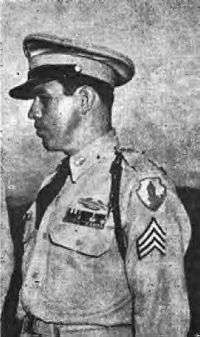Agustín Ramos Calero
Sergeant First Class Agustín Ramos Calero[note 1] (June 2, 1919 – February 10, 1989) was awarded 22 decorations and medals from the U.S. Army for his actions during World War II, thus becoming the most decorated Puerto Rican and Hispanic soldier in the United States military during that war.[1][2]
Agustín Ramos Calero | |
|---|---|
 SFC. Agustín Ramos Calero Most decorated Hispanic in World War II | |
| Birth name | Agustín Ramos Calero |
| Nickname(s) | One-Man Army |
| Born | June 2, 1919 Isabela, Puerto Rico |
| Died | February 10, 1989 (aged 69) |
| Buried | |
| Allegiance | |
| Service/ | |
| Years of service | 1941–1962 |
| Rank | Sergeant First Class |
| Unit | |
| Battles/wars | World War II Korean War |
| Awards | |
Early years
Calero was born and raised in the town of Isabela, Puerto Rico, which is located in the northern region of Puerto Rico. The economic situation in Puerto Rico during the 1930s was difficult as a result of the Great Depression. Due to the shortage of jobs in the island, many Puerto Ricans joined the United States Army which offered a guaranteed income.[2]
World War II
In 1941, Calero joined the Army and was assigned to Puerto Rico's 65th Infantry Regiment at Camp Las Casas in Santurce, Puerto Rico. There he received his training as a rifleman. Upon the outbreak of World War II, Calero was reassigned to the Third U.S. Infantry Division and sent to Europe. In 1945, Calero's company was in the vicinity of Colmar, France and engaged in combat against a squad of German soldiers in what is known as the Battle of Colmar Pocket. Calero attacked the squad, killing ten of them and capturing 21 shortly before being wounded himself. Following these events, he was nicknamed "One-Man Army" by his comrades.[1] For these actions he was awarded the Silver Star. Calero had been wounded a total of four times in Europe when the war ended. He was awarded a total of 22 decorations and medals for his actions, making him the Puerto Rican soldier with the most military decorations in all of the United States during that conflict.[2][3]
Korean War
Calero returned to Puerto Rico and was reassigned once more to the 65th Infantry Regiment. The 65th Infantry departed from Puerto Rico on August 26, 1950, when the United States became involved in the Korean War. They arrived in Pusan, Korea on September 23. In Korea, Calero was assigned to Headquarters and Headquarters Company of the regiment. He was the personal assistant to the regimental commander, Brigadier General (then Colonel) William W. Harris.[2][4]
Later years
Calero retired from the U.S. Army in 1962 after total of 21 years of service. He retired with the rank of Sergeant First Class. At the end of his years, Calero suffered from terminal cancer. Sergeant First Class Agustín Ramos Calero died on February 10, 1989, at 69 years of age and was buried with full military honors in the Puerto Rico National Cemetery in Bayamón, Puerto Rico.[5] His hometown, Isabela, honored his memory by naming an avenue after him.[6]
Notes
- This article uses Spanish naming customs: the first or paternal family name is Ramos and the second or maternal family name is Calero.
Military awards and decorations
Among Calero's decorations were the following:
| Silver Star | |||
| Purple Heart with three oak leaf clusters | Presidential Unit Citation | Meritorious Unit Commendation | American Campaign Medal |
| European-African-Middle Eastern Campaign Medal with four bronze service stars | World War II Victory Medal | Army of Occupation Medal | National Defense Service Medal |
| Korean Service Medal | French Croix de Guerre | United Nations Korea Medal | Republic of Korea Presidential Unit Citation |
Badges:
Foreign unit decorations.

The Bravery Gold Medal of Greece was given by the Government of Greece to the 65th Infantry Regiment and to the members of the regiment who fought in the Korean War.

Congressional Gold Medal
On June 10, 2014, President Barack Obama, signed the legislation known as "The Borinqueneers CGM Bill" at an official ceremony. The Bill honors the 65th Infantry Regiment with the Congressional Gold Medal.[7][8][9][10]
See also
References
- Who was Agustín Ramos Calero? Archived 2011-10-09 at the Wayback Machine
- "Interview: "The Borinqueneers", August 2005; Captain Charles E. Boyle; Operations and Intelligence Section of the 65th Regimental Headquarters from 1950-1951
- Noemi Figueroa Soulet Archived 2006-08-25 at the Wayback Machine, The Puerto Rican Soldier, August 17, 2005. PDF format. Retrieved November 19, 2006.
- "Agustín Ramos Calero mystery solved" (PDF). Archived from the original on 2007-10-06. Retrieved 2009-07-04.CS1 maint: BOT: original-url status unknown (link), 'The Puerto Rican Soldier. Retrieved from Archive.org on July 4, 2009.
- Puerto Rico National Cemetery, Bayamón, Puerto Rico.
- Reference to SFC Agustín Ramos Calero Ave.
- Obama honors Puerto Rican Infantry Regiment with Congressional Gold Medal, Washington Post, June 10, 2014.
- Dan Friedman, "Puerto Rico's Borinqueneers recognized with Congressional Gold Medal," New York Daily News, June 11, 2014.
- Obama awards Borinqueneers Congressional Medal of Honor, NBC News, June 10, 2014.
- Richard Payerchin, "President Obama to honor Army's Puerto Rican regiment the Borinqueneers," The Morning Journal, June 9, 2014.
Further reading
- Puertorriquenos Who Served With Guts, Glory, and Honor. Fighting to Defend a Nation Not Completely Their Own, by Greg Boudonck, ISBN 978-1497421837
External links
- Who was Agustín Ramos Calero?. Retrieved November 19, 2006.
- The Puerto Rican Soldier News. Retrieved November 19, 2006.
- Puerto Rico National Cemetery, Bayamón, Puerto Rico. Retrieved November 19, 2006.